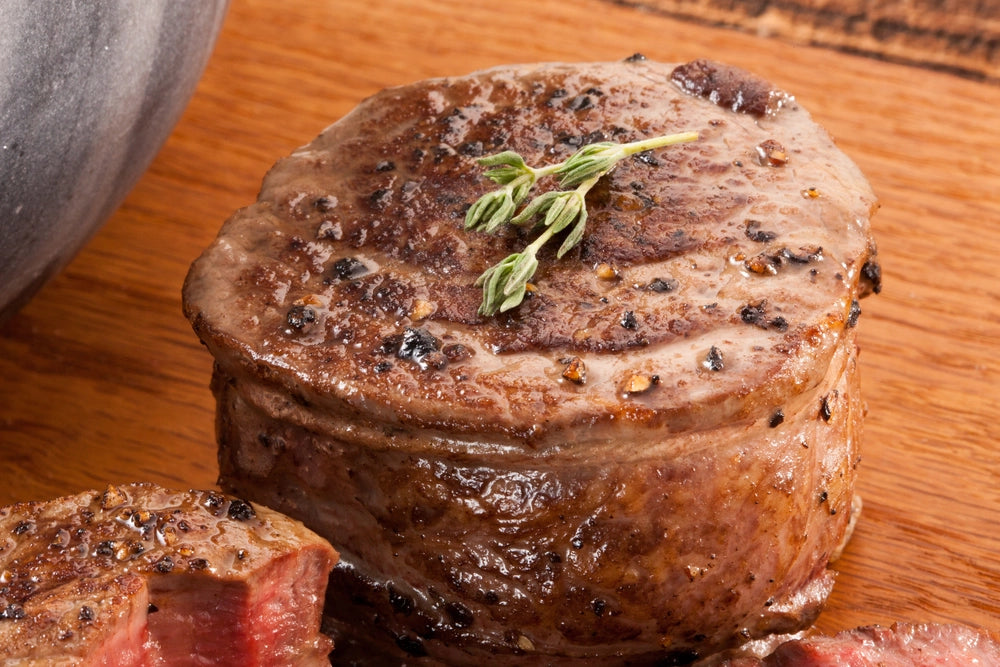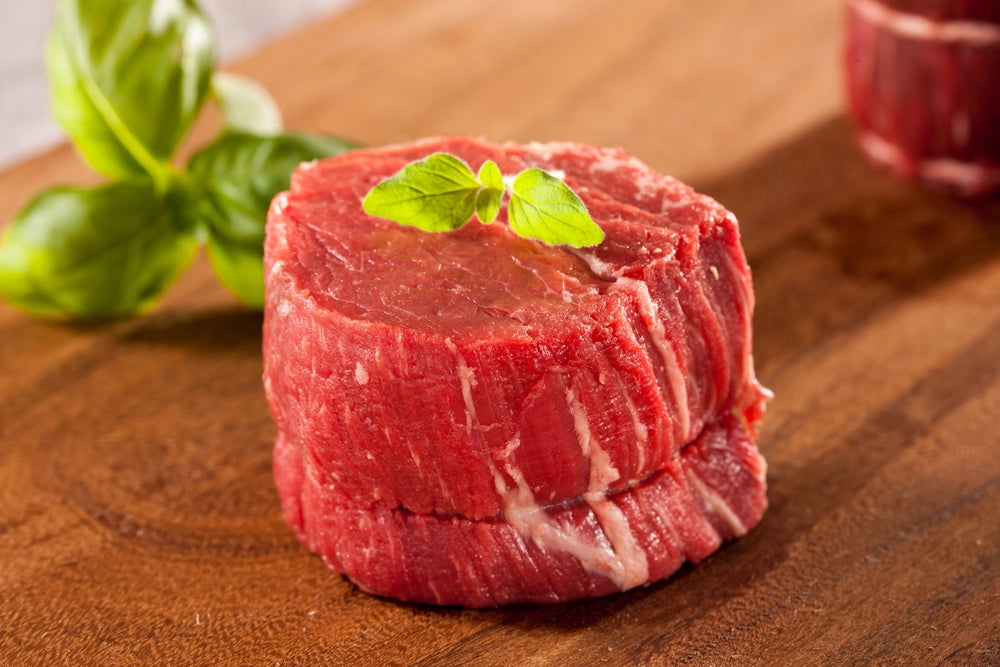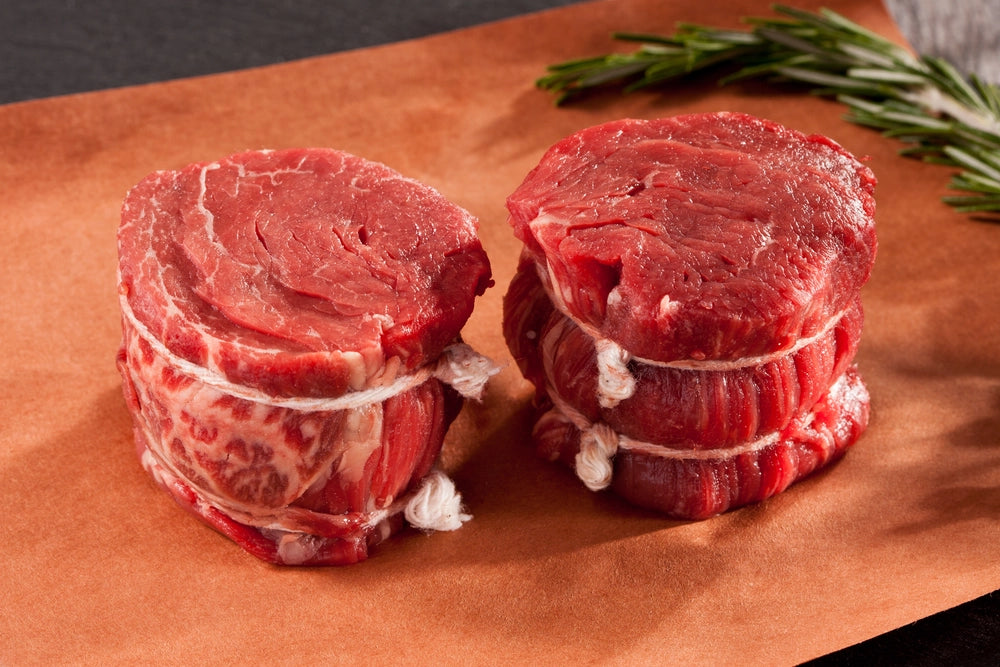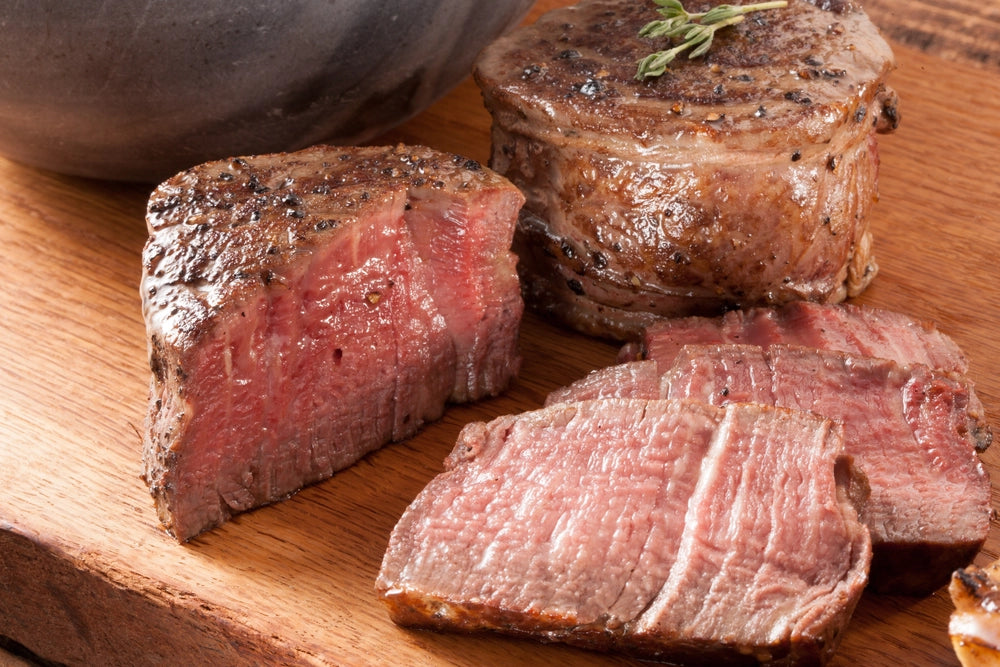Few dishes in culinary history carry the elegance and prestige of filet mignon. A gem in the crown of French cuisine since its invention in the 19th century, it became a celebrated cut of beef in America in the 20th century thanks to its tender, melt-in-your-mouth quality. It’s a cut of beef that ascended to fine-dining stardom due as much to its exclusivity as its taste.
The best filet mignon comes from grass-fed beef that offers a unique combination of flavor and high nutritional value. Acabonac Farms is a source for high-quality, sustainable and ethically-sourced grass-fed beef. The following provides a comprehensive guide to understanding, selecting, cooking and enjoying filet mignon.
Key Takeaways
- Filet mignon is a premium cut of beef taken from the smaller end of the tenderloin. Renowned for its tender texture and subtle flavor, it is considered one of the most prized and luxurious beef cuts. It’s also considered an exclusive cut due to the small amount of filet mignon yielded per cow.
- The filet mignon experience starts with choosing the right cut of beef. The best are grass-fed filet mignon from a trusted source like Acabonac Farms. Grass-fed filet mignon offers a better flavor profile and higher quality due to natural feeding and farming practices.
- Less is more with a quality cut of grass-fed filet mignon. To maintain its delicate texture and flavor, filet mignon benefits from simple seasoning. Salt, freshly ground black pepper and a bit of olive oil are often all that’s needed.
- Serving filet mignon with complementary sides and garnishes can elevate the entire dining experience. Choices range from creamy mashed potatoes to a simple arugula salad - and, of course, pairing with cabernet sauvignon or another red wine.

What is Filet Mignon?
Just the name “filet mignon” conjures up visions of dining luxury. The soft texture, subtle flavor and overall high quality of filet mignon has led to it becoming a beloved staple on menus around the world. It’s served in the finest restaurants and sought after by connoisseurs. While once a cut of beef available only for the richest steak lovers, filet mignon is now available to households everywhere.
Created in France (the name means “dainty filet”), the filet mignon is cut from the smaller end of the tenderloin. The tenderloin runs along the spine of the cow. It’s not a weight-bearing muscle so therefore not toughened through use, which is why the filet mignon is so succulent and tender.
The fame of the filet mignon is as much an American story as a French one. The steak made a notable appearance in O. Henry’s 1906 short story, "The Four Million." A struggling artist named Joe tells his wife, Delia, that they should celebrate a sudden influx of cash by enjoying “filet mignon with champignons.” The famous story offered an example of how Americans associated filet mignon with luxury and sophistication, and offers insight into why the steak enjoyed more widespread popularity in the United States than it did in France.
Starting in the early 20th century, filet mignon began to feature prominently on menus of upscale American restaurants, capturing the imagination of diners with its exceptional tenderness and flavor. Its ascent in the culinary world was marked by its association with dining elegance, a status it maintains to this day.
Filet Mignon Benefits
Filet mignon is prized for its exceptional tenderness, as it comes from the tenderloin, a muscle that gets minimal use, resulting in a buttery texture. This premium cut is known for its mild, rich flavor and is often considered one of the most luxurious options for beef. Its texture and taste make it a favorite for special occasions and gourmet meals.
Nutritionally, filet mignon provides high-quality protein that supports muscle growth and repair, along with essential nutrients like iron, zinc, and B vitamins, which aid in energy production and immune health. It is also relatively low in fat compared to cuts like ribeye, making it a leaner yet flavorful option. When paired with nutrient-dense sides, filet mignon can be part of a delicious and balanced meal.
What Does Filet Mignon Taste Like?
Filet mignon is renowned for its exceptionally tender texture and subtle, yet rich flavor. Unlike more marbled cuts of beef, filet mignon offers a more delicate beef flavor. Its tenderness is almost buttery, allowing it to melt in the mouth - a hallmark of its appeal.
Those who enjoy steak will find a big difference between grain-fed and grass-fed filet mignon. A grass-fed filet mignon produced on a small farm offers a more complex flavor profile than grain-fed beef, as well as a slightly firmer texture due to lower fat content. The result is a more authentic beef experience than beef from a large, industrial operation. Filet mignon always ranks among the most popular grass-fed beef choices.

How Do You Choose the Best Filet Mignon?
When purchasing filet mignon, several factors should be taken into account to ensure you're selecting the best possible cut that delivers on flavor, tenderness and overall quality. The best filet mignon cuts are evenly shaped and thick, typically between 1.5 to 2 inches. This allows for a better sear on the outside while maintaining a tender, juicy interior when cooked.
While filet mignon is known for being lean, look for slight marbling that contributes to the steak's flavor and juiciness. Excessive marbling is not typical for filet mignon. Fresh filet mignon should also have a vibrant, red color. Meat that looks brown or dull may be past its prime.
Also, consider the source of the beef, which can provide insight into the beef's quality, flavor profile and ethical considerations. Beef labeled as grass-fed, for example, comes from cattle that have been fed a natural diet and raised in more humane conditions, resulting in leaner meat with a distinctive flavor. Also, the country of origin can affect taste and quality due to different farming practices and standards.

How to Prepare Filet Mignon
To ensure your filet mignon cooks perfectly and tastes delicious, start with proper preparation. Here are the steps to prepare your steak:
- Thawing: If frozen, thaw in the refrigerator about 24 to 48 hours before cooking.
- Tempering: Bring the filet mignon to room temperature before cooking
- Drying: Pat the filet mignon with a paper towel to remove excess moisture
- Seasoning: Season both sides with salt and pepper. Optional: add a rub or other seasonings
- Pre-heating cooking surfaces: If you’re cooking on the stove top, pre-heat heavy-bottomed or cast iron skillet to achieve an even and thorough sear. On a grill, preheat to a high temperature but also leave a cooler area on the grill to finish the steak.
Other tools that will help in cooking a filet mignon include tongs to flip the filet mignon without piercing the meat, a sharp knife for clean and precise cutting, and a baking sheet or wire rack that allows for even heat circulation if you finish the filet mignon in the oven. Also, oil with a high smoke point, such as avocado or sesame oil, is helpful if you use the reverse sear cooking method.
What’s the Best Way to Cook Filet Mignon?
Filet mignon is a special cut, and it deserves special attention in how it is cooked. The most popular methods are grilling, pan-searing and oven-roasting. In each case, you’ll want to reach the following internal temperature for different levels of doneness: medium rare (130°F to 135°F); medium (140°F to 145°F); medium well (150°F to 155°F); and well done (160°F to 165°F).
Grilling a Filet Mignon
Grilling filet mignon is a fantastic way to achieve a flavorful crust while keeping the interior juicy and tender. Here’s a step-by-step guide to grilling this premium cut to perfection,
Preparation. Defrost the filet mignon in the refrigerator, then let it sit out for about a half hour at room temperature to promote even cooking. Remove excess moisture with a paper towel. Season on all sides with salt and freshly ground black pepper. For added flavor, you can rub the steak with olive oil and your choice of herbs or garlic.
Preparing the grill. Heat the grill to a high temperature. For charcoal grills, distribute coals to create a hot zone and a cooler zone. For gas grills, set one side to high heat and another to a lower temperature. Once hot, clean the grill grates with a brush to remove any residue. Then, using tongs, rub a folded paper towel soaked in cooking oil over the grates to prevent sticking.
Grilling the steak. Place the filet mignon on the hottest part of the grill. Sear each side for two to four minutes to develop a rich, brown crust. Avoid moving the steak around to ensure good grill marks. Once seared, move the steak to a cooler part of the grill or lower the gas heat. Continue cooking to your desired level of doneness, using a meat thermometer to check the temperature. You can also baste for flavor during the last few minutes of grilling with melted butter and herbs for additional flavor.
Resting the steak. Transfer the grilled filet mignon to a plate or cutting board and cover loosely with aluminum foil. Let it rest for five to 10 minutes. Resting allows the juices to redistribute throughout the meat, ensuring a moist and tender steak upon cutting.
Pan-Searing a Filet Mignon
Pan-searing filet mignon is a classic method that yields a beautifully caramelized crust with a tender, juicy interior.
Preparing the meat. Bring the filet mignon to room temperature to promote even cooking.
Pat the steak dry with paper towels. Season generously on all sides with salt and freshly ground black pepper. Add other seasonings or herbs if desired.
Preparing the pan and ingredients. Place a heavy skillet, preferably cast iron, over medium-high heat. Let it get very hot before adding the oil. A hot pan is crucial for a good sear. Have oil, butter, and any aromatics (like garlic or rosemary) ready. High smoke point oils are best for searing.
Searing the steak. Once the pan is hot, add a tablespoon of oil and swirl to coat the bottom. Carefully place the filet mignon in the pan. It should sizzle immediately. Sear the steak for about two to three minutes on one side, or until a golden-brown crust forms. Use tongs to flip the steak gently and sear for another two to three minutes. Avoid moving the steaks around while searing.
As an option, after flipping the steak, add a couple tablespoons of butter to the pan along with any desired aromatics. Tilt the pan slightly and use a spoon to baste the steak with the buttery juices. This adds flavor and helps cook the steak evenly.
Resting the steak. Let the steak rest on a plate for five to 10 minutes and allow juices to redistribute throughout the meat, ensuring a tender and juicy steak.
Oven-Roasting a Filet Mignon
Oven-roasting filet mignon is an excellent method for achieving a tender, evenly cooked steak with minimal fuss.
Preparing the filet mignon. Remove the filet mignon from the refrigerator and allow it to sit at room temperature for about 30 minutes to promote even cooking. Pat the steak dry and season to taste with salt and freshly ground black pepper. Lightly rub the steak with olive oil and add herbs like thyme or rosemary for additional flavor.
Preparing to roast. Preheat the oven to 400°F (205°C). A high temperature is crucial for a nice sear and a juicy interior. Also, heat a heavy, oven-safe skillet (cast iron is ideal) or a roasting pan. If using a skillet, you can start on the stovetop and then transfer directly to the oven.
Cooking the steak. It’s optional, but recommended, to sear a filet mignon on a skillet for two to three minutes on both sides before placing it in the oven. This step adds a nice crust. Once seared, place the steak in an oven-safe skillet and place the skillet directly into the preheated oven. If not, transfer the seared steak to a preheated roasting pan.
Roast the filet mignon in the oven until it reaches your preferred level of doneness. Use a meat thermometer to ensure meat is properly cooked.
Resting the steak. As with all cooking methods, it’s important to rest the steak once it is cooked. This increases tenderness by allowing juices to redistribute throughout the meat.

Tips for Serving Filet Mignon: Pairings and Presentation
Filet mignon pairs beautifully with a variety of side dishes and wines. The goal is to complement the steak without overwhelming its delicate taste.
Choices for side dishes include creamy and smooth garlic mashed potatoes, sauteed mushrooms, grilled vegetables or a simple arugula salad with a lemon vinaigrette that adds a light, peppery and acidic component to the meal.
For wine, cabernet sauvignon is the quintessential pairing for red meat. Merlot offers a softer, less tannic red, while a pinot noir provides a more delicate red. A Bordeaux blend offers a balance of cabernet sauvignon's strength with the softness of Merlot, complementing both the steak and a variety of sides.
To properly prepare filet mignon for presentation, slice against the grain, not with the grain.
Where to Buy the Best Grass-Fed Filet Mignon Online
Acabonac Farms’ cattle live on green grassy pastures near the Atlantic Ocean. They are raised with no antibiotics, fillers or hormones, providing the most pure, 100% grass-fed filet mignon or filet mignon beef tips that you can find. When you order from Acabonac Farms, your filet mignon arrives at your front door. You’ll taste the difference that our sustainable, small farm operation brings to this timeless, classic steak. It’s the perfect choice for your next special occasion.
Frequently Asked Questions about Filet Mignon
Why is filet mignon so expensive?
Filet mignon commands a higher price than many other cuts of beef because of its characteristics and flavor, the scarcity of the cut because the tenderloin yields only a limited amount of filet mignon per animal, and the high demand for this premium cut that is associated with sophistication and special occasions.
Is filet mignon better than ribeye?
Personal tastes differ. Many prefer filet mignon because it comes from the tenderloin, making it the most tender of beef cuts, and because it has a mild beef flavor when compared to fattier cuts. Its subtle taste makes it a favorite for those who prefer less intense beefy flavors, such a might be found with a ribeye.
What is the difference between filet mignon and tenderloin?
Filet mignon is a cut from the tenderloin, a long, narrow muscle that runs along the spine of the cow. The tenderloin can be cooked whole as a roast or sliced into individual steaks. Steaks cut from the tenderloin include filet mignon from the smaller end of the tenderloin and chateaubriand from the thicker portion.
How long should filet mignon be cooked for medium-rare?
The cooking time to make medium-rare filet mignon depends on the cooking method. For grilled filet mignon, it typically takes about four to five minutes on one side and another three to five minutes on the other side to achieve medium-rare. For over-roasting, it takes about eight minutes at 425°F after searing it on the stovetop. For pan-searing, a 1.5-inch thick filet mignon typically needs about five to seven minutes total cooking time for medium-rare. All these times are approximate. Use a meat thermometer to ensure the meat reaches the proper temperature.
Can filet mignon be cooked from frozen?
Filet mignon should be thawed in the refrigerator and then allowed to come to room temperature for about 30 minutes before cooking.
How many filet mignon per cow?
Each cow typically provides 12 to 16 filet mignon steaks, depending on the size of the animal and how the butcher cuts the meat. The filet mignon comes from the tenderloin, a long, narrow muscle that runs along the spine. Since the tenderloin is a relatively small muscle, it only yields a limited number of filet mignon portions per cow.
